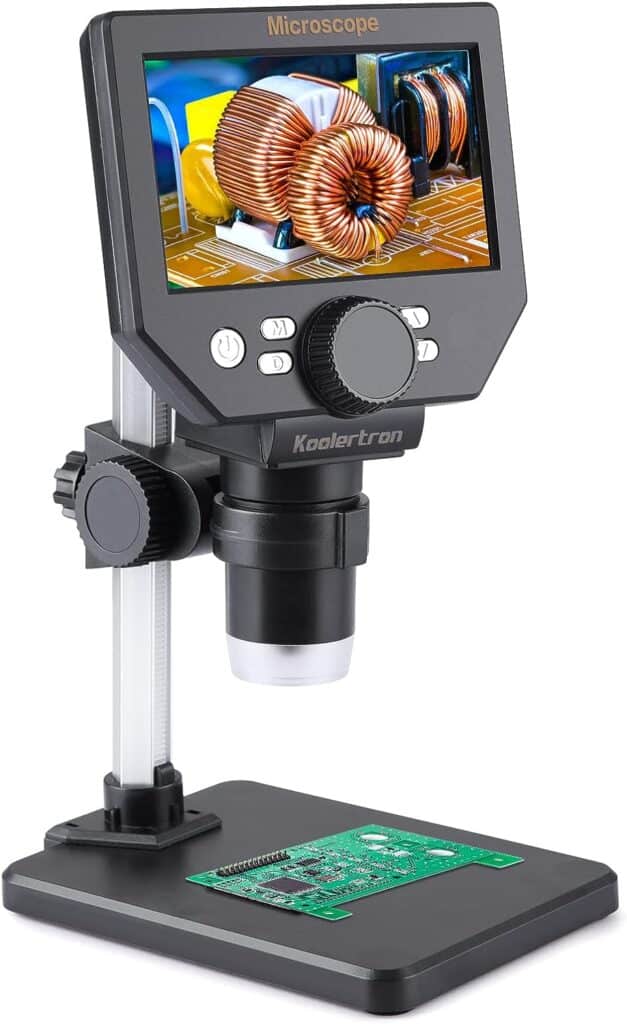When we repair electronic devices, we may need to do microsoldering, which is carefully joining tiny components. This precise technique is crucial for fixing the intricate parts inside smartphones, laptops, and other gadgets. To become skilled at microsoldering, we need to understand the tools and techniques required for success. These include a good quality soldering iron, fine-tipped solder, and flux. Beginners can start by practicing on old circuit boards to build their skills. Patience and steady hands are essential since the work requires great precision.
As we advance, we’ll learn more complex techniques for repairing devices. This skill takes time to master but can be very rewarding. Microsoldering allows us to fix broken connectors and replace tiny resistors, opening up new possibilities for electronic repair enthusiasts. In the world of electronics repair, microsoldering is a game-changer. It’s a delicate skill that calls for precision, skill, and specialized tools. This article goes deep into microsoldering, exploring its tools, techniques, applications, and challenges. Whether you’re a curious tech enthusiast or someone with a broken device, this guide will provide insight into this fascinating repair technique.
Microsoldering: The Complete Beginner’s Guide
Microsoldering is a precision soldering technique used to repair or modify tiny electronic components on circuit boards — such as those found in smartphones, laptops, and game consoles. Unlike traditional soldering, microsoldering requires special tools, magnification, and steady hands to work with components smaller than a grain of rice.
🧠 What Is Microsoldering?
Microsoldering involves using a fine-tipped soldering iron or hot air rework station to connect or remove micro-scale components like:
- SMD (Surface-Mount Device) capacitors, resistors, and ICs
- Connectors on logic boards (e.g., iPhone charging ports)
- Traces, pads, and jumpers on PCBs
It’s essential for board-level electronics repair, especially in smartphones and laptops where parts are not modular.
Sources:
- ElectronicsHub – Micro Soldering: Everything You Need To Know
- iFixit – Microsoldering Beginner’s Guide
🧰 Essential Tools and Equipment
According to Microsoldering.com and industry experts, here’s what you’ll need to start:
🔍 Magnification
- Microscope (Trinocular or Digital) – Essential for seeing small components clearly.
- Ring light or LED illumination – Provides consistent lighting.
🔥 Soldering & Rework Tools
- Micro soldering iron (e.g., JBC, Hakko, or Quick) with fine tips
- Hot air rework station for removing chips and connectors
- Preheater (optional) to warm the board evenly before soldering
🧴 Consumables
- Solder wire (preferably leaded 63/37 for beginners)
- Flux paste or liquid – Improves solder flow and prevents oxidation
- Solder wick (braid) – For removing excess solder
- Kapton tape – Heat-resistant tape to protect nearby components
🔌 Diagnostic Tools
- Multimeter – For checking continuity and voltage
- Power supply – For testing circuits safely
- Microsoldering schematics tools (e.g., ZXW Tools, BoardView software)
⚙️ Step-by-Step: How to Microsolder
Step 1: Prepare Your Workspace
- Work on a clean, static-free surface.
- Use an ESD mat and wrist strap to prevent static damage.
- Ensure your microscope and lighting are properly positioned.
Step 2: Secure the Board
- Place your logic board or PCB in a board holder or fixture.
- Clean the area with isopropyl alcohol (99%) to remove oils and dust.
Step 3: Apply Flux
- Add a small amount of flux to the pads or joints you’ll be working on.
- Flux helps solder flow smoothly and prevents oxidation.
Step 4: Tin the Iron Tip
- Apply a small amount of solder to the iron tip before touching the joint.
- This ensures good heat transfer and prevents oxidation.
Step 5: Solder the Component
- Align the component precisely using tweezers.
- Gently touch the pad and component lead with the iron tip until solder flows.
- Remove the iron and allow it to cool naturally.
Step 6: Inspect Your Work
- Use the microscope to check for cold joints, bridges, or misalignment.
- Clean the area with isopropyl alcohol and a soft brush.
⚠️ Common Mistakes to Avoid
According to GoToPAC’s Microsoldering Experts:
- Overheating components – Use proper temperature control (320–370°C).
- Using too much solder – Leads to bridging or short circuits.
- Skipping flux – Causes poor solder joints.
- Not cleaning the board – Residue can cause corrosion or shorts.
- Lack of magnification – You can’t fix what you can’t see.
🧪 Practice Projects for Beginners
Before working on real devices, practice on:
- Old or scrap circuit boards
- Broken smartphones or laptops
- Solder training kits (available on Amazon or AliExpress)
Start with:
- Removing and replacing capacitors or resistors
- Repairing broken pads or traces
- Reballing small ICs (advanced)
🧑🔧 Safety Tips
- Always wear eye protection.
- Work in a well-ventilated area or use a fume extractor.
- Never touch the iron tip or hot air nozzle.
- Unplug equipment when not in use.
🧭 When to Use Microsoldering
Microsoldering is commonly used for:
- iPhone logic board repairs (e.g., Tristar, U2, Touch IC)
- MacBook board-level fixes (charging, backlight issues)
- Game console HDMI port or power IC replacements
- Data recovery from damaged boards
🧩 Learning Resources
- iFixit Microsoldering Beginner’s Guide
- ElectronicsHub – Micro Soldering Explained
- Microsoldering.com – Tools & Equipment
- GoToPAC – Common Microsoldering Mistakes
- AiXun Tech – Comprehensive Guide for Beginners
✅ Summary
| Category | Key Takeaway |
|---|---|
| Definition | Precision soldering of micro components on PCBs |
| Tools Needed | Microscope, fine soldering iron, flux, multimeter |
| Best Practice | Use flux, control heat, inspect under microscope |
| Common Mistakes | Overheating, excess solder, poor cleaning |
| Applications | Phone, laptop, and console board repair |
Repairing the Future, One Tiny Connection at a Time
Microsoldering is a highly specialized technique used to repair tiny components on circuit boards that are too small for standard soldering tools. These components are often as small as a grain of sand, requiring specialized tools and a steady hand under a microscope. It’s a meticulous process, but it can bring seemingly irreparable electronics back to life.

The Tools of the Trade
Microsoldering isn’t your average DIY project. It requires specific tools designed for precision and control:
| Tool | Description |
|---|---|
| Microscope | Provides magnification (up to 100x) to see the tiny components and solder joints clearly. |
| Soldering Iron | A special iron with a very fine tip for precise heat application. |
| Solder Wire | Thin solder wire with a low melting point for delicate connections. |
| Flux | A chemical cleaner that removes oxidation and improves solder flow. |
| Precision Tweezers | Used to hold and manipulate tiny components. |
| Heat Gun or Hot Air Station | Provides controlled heat to reflow solder or remove components. |
Techniques: More Than Just Melting Metal
Microsoldering involves a variety of techniques depending on the specific repair needed:
- Trace Repair: Repairing broken or damaged copper traces on the circuit board.
- Component Replacement: Removing and replacing faulty components like resistors, capacitors, or even microchips.
- BGA Rework: Replacing Ball Grid Array (BGA) chips, which have tiny solder balls underneath that connect to the board.
The Applications: Where Microsoldering Shines
Microsoldering is used in a wide range of electronics repair, from smartphones and laptops to gaming consoles and even medical devices. It’s particularly useful for:
- Water Damage Repair: Fixing corroded components or broken connections caused by liquid exposure.
- Logic Board Repair: Addressing issues with the main circuit board, such as problems with power, charging, or display.
- Data Recovery: Retrieving data from devices with damaged storage components.
The Challenges and Risks
Microsoldering is not without its challenges. It requires a high level of skill, patience, and attention to detail. Mistakes can be costly, potentially damaging the device further or rendering it completely unusable. Additionally, the heat from soldering can damage nearby components if not applied carefully.
The Future of Microsoldering
As electronics continue to shrink in size and increase in complexity, microsoldering will become even more important. Advancements in tools and techniques will continue to push the boundaries of what’s possible in electronics repair. As a result, microsoldering will play a critical role in extending the lifespan of our devices and reducing electronic waste.
Should You Try It Yourself?
While there are online resources and tutorials available, microsoldering is not recommended for beginners. It’s a specialized skill that requires training and practice to master. If you have a valuable device in need of repair, it’s best to leave it to the professionals.
Key Takeaways
- Microsoldering is vital for repairing small electronic components.
- Basic tools needed include a soldering iron, fine-tipped solder, and flux.
- Advanced techniques allow for more complex repairs.
Understanding Microsoldering
Microsoldering involves soldering small electronic components on a circuit board with precision equipment. This skill is crucial for repairing modern electronics, which rely on tiny and delicate parts.
Fundamentals of Microsoldering
Microsoldering is the art of joining very small electronic components to a circuit board. This process requires steady hands, keen eyesight or a good microscope, and precise control over tools.
Safety is a primary concern. Proper ventilation and fume extraction should be in place because the soldering process emits harmful fumes. Wearing safety glasses is recommended to protect the eyes from potential splashes.
Understanding the behavior of solder and flux is key. Solder melts and flows to create electrical connections, while flux cleans the surfaces and prevents oxidation during soldering.
Essential Tools and Equipment
Effective microsoldering needs specific tools. A high-quality soldering iron with temperature control ensures consistent heating. Ultra-fine soldering tips enable precision work.
A microscope or magnifying glass allows technicians to see small components clearly. Tweezers help in handling tiny parts.
A hot air rework station is useful for removing and replacing components. It blows heated air to melt solder without direct contact.
Other common tools include a multimeter for testing connections and a flux pen for applying flux precisely. Different types of solder wire and soldering tips suit various tasks.
Materials and Components
Several materials are essential. Solder wire primarily contains tin and some lead or other metals to provide strength and conductivity. Lead-free solder is often used to comply with environmental standards. Different diameters of solder wire are available, with thinner wire being useful for precision work.
Flux helps solder flow smoothly, preventing oxidation at soldered joints. It’s available in paste and liquid forms. Isopropyl alcohol is used for cleaning the board after soldering to remove flux residue.
Common components in microsoldering include ultra-fine wires, microchips, resistors, capacitors, and connectors. Each component has specific handling and soldering requirements.
Microsoldering Techniques and Processes
Preparation is crucial. This includes cleaning the work area and ensuring the circuit board and components are free of debris. Applying flux to areas being soldered helps achieve clean connections.
Precise control of the soldering iron is necessary. Solder flows best when the tip is clean, and temperature is carefully controlled. The iron tip should touch both the component lead and the circuit board pad simultaneously for proper heat transfer.
Reflow soldering can be used for delicate components. This technique involves applying solder paste to the board, placing components, and then heating the entire assembly to cause solder to reflow and bond.
During the process, keeping a steady hand and maintaining focus are imperative. Micro soldering techniques can vary depending on the specific repair or project, but careful, patient methods yield the best results.
Frequently Asked Questions
Microsoldering involves detailed work with tiny components, requiring specialized tools and techniques. Addressing common issues, safety measures, and skill development is essential.
What essential tools are required for microsoldering tasks?
Microsoldering tasks need a variety of tools. Essential ones include a quality soldering iron with fine tips, precision tweezers, a microscope, flux, and solder. Additional helpful tools are a hot air rework station and ultrasonic cleaner.
How does microsoldering differ from traditional soldering techniques?
Microsoldering involves working on much smaller components than traditional soldering. It requires more precision and steady hands. Traditional soldering is often used for larger components and simpler tasks.
What are the common challenges encountered during microsoldering operations?
Challenges in microsoldering include dealing with very small components and ensuring precise alignment. Identifying and fixing faults on tiny circuit boards can be tricky. Another issue is managing heat to prevent damage to delicate parts.
What safety precautions should be observed when microsoldering?
Safety precautions include using proper ventilation to avoid inhaling fumes and wearing safety glasses to protect eyes from splashes. Ensuring the workspace is clean and organized helps prevent accidents. Using tools with heat protection can avoid burns.
How can beginners develop proficiency in microsoldering?
Beginners can develop proficiency by starting with simpler projects and gradually tackling more complex tasks. Enrolling in specialized courses and watching tutorial videos can provide valuable guidance. Consistent practice is key to building skills.
What is the typical melting point range for lead-free solder in microsoldering?
The typical melting point range for lead-free solder is between 217 to 221 degrees Celsius. This temperature range helps in forming strong joints without damaging the components. Using the correct temperature setting on the soldering iron is critical for success.



